North and east of Jurien Bay, the road to Coorow passes through Alexander Morrison National Park. We may not have taken long to traverse it, as we drove eastward on the morning of September 17, 2013, but even brief stops on the way were enough to fill our cameras with the images of a host of flowers.
The flora of Alexander Morrison is almost overwhelming: over 400 species of flowering plants have been recorded from the area. Like Lesueur National Park, to which I have already devoted several posts, this is Kwongan country - dry sandplain heath that might at first seem inimical to high plant diversity, but whose very harshness has created a host of microniches for which its plants have, in myriad ways, specialized. Today, species after species crowd cheek by jowl into a dense mass of growth.
The sandy soil, and grey-green foliage of many of the plants, made the clusters of spring flowers stand out, if anything, even more sharply - much to the delight of our traveling companions.
As elsewhere in the Kwongan, the shrub layer is dominated by two plant familes, the proteas (Proteaceae) and the myrtles (Myrtaceae). Proteas are particularly diverse here; according to the park website there are twenty different species of dryandra alone.
This one, as far as I can tell, is Many-headed or Showy Dryandra (Banksia polycephala) another Kwongan specialty with a limited range.
There are at least ten species of Petrophile in the area. This one, I believe, is Drummond's Petrophile (Petrophile drummondii).
Drummond's Petrophile is a particularly spiky plant; the needle-like tips of its leaves explain why we did most of our flower photography from the side of the road.
Spreading Coneflower (Isopogon divergens), another of the proteas, grows over a fairly broad area of the western coast. There are at least half a dozen other species in the area.
Hakeas are even more diverse: some fourteen species are listed for the area.
This one is is Hakea gilbertii (well, I think all these photos are of the same species!).
Hakea gilbertii can come in either white or pink; I find the deep blush of pink of these flowers particularly beautiful.
The bright red flowers of this Adenanthos are typical of many proteas, but their arrangement into an inflorescence is quite unlike the great globular flower heads of dryandras and coneflowers.
Even less like what we think of as a typical protea (as I have noted before) are the flowers of the synapheas and smokebushes. Synaphea spinulosa subsp borealis is the northern form of a widespread southwestern species.
I am not sure which of the dozen species of smokebush (Conospermum) recorded for the area this is.
Long-leaved Clawflower (Calothamnus longissimus) is one of the myrtles, and a striking one at that; Calothamnus is certainly one of the most distinctive-looking of myrtle genera.
Much more typical of many myrtles are the flowers of this melaleuca, probably Coastal Honey-Myrtle (Melaleuca systena) - clusters of coloured stamens, white in this species, but often pink in others of its genus.
Here is one of the pink ones, probably Rough Honey-Myrtle (Melaleuca scabra) [listed for the area, but according to Florabase this is primarily a south coast species; however, this name probably represents a whole complex of forms rather than a single plant].
The stamens are even more striking in Sticky Eremaea (Eremaea beaufortioides).
In other myrtles the petals are the most obvious part of the flower, as in this species of Calytrix.
This reaches a peak in the beautiful and varied featherflowers (Verticordia spp), in which the petals are set off by a fringed halo of coloured sepals. We'll see more verticordias in our next instalment; there are at least sixteen species in the area (This may be Compacted Featherflower (Verticordia densiflora)).
Proteas and myrtles, of course, were not the only plants in the park. This appears to be Blakely's Wattle (Acacia blakelyi), a widespread (and widely planted) species in the Kwongan.
These appear to be different species of Hibbertia (Goodeniaceae). There are seven species recorded for the are, and I can't find photos of most of them.
Bushy or Terete-leaved Dampiera (Dampiera teres) is another flower in the Goodeniaceae, whose flowers do seem to come either in blue or yellow.
Popflowers (Glischrocaryon sp) were also common along the roadside, a we had found them to be in much of the Kwongan and further east.
Finally (though there will be more from Alexander Morrison in my next entry) here is something I cannot even identify to family. It's certainly odd-looking, and I would be grateful to my readers for ideas!

















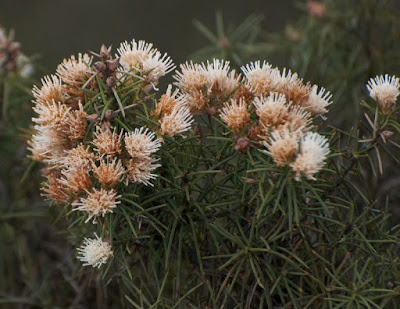








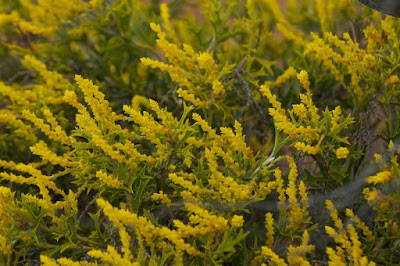

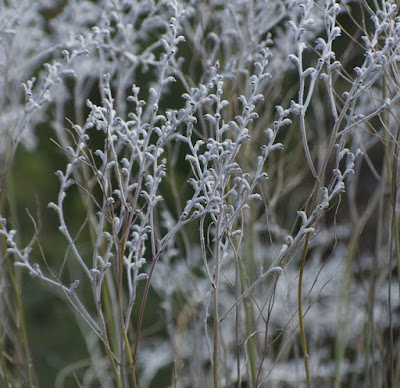
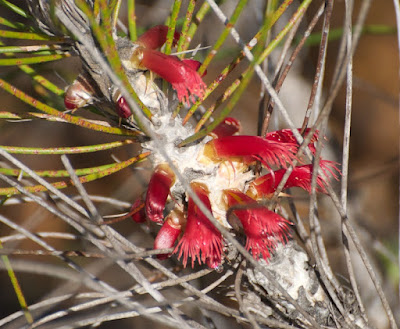

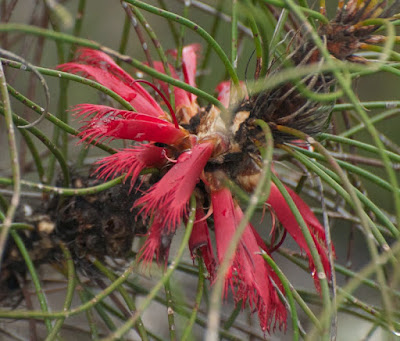










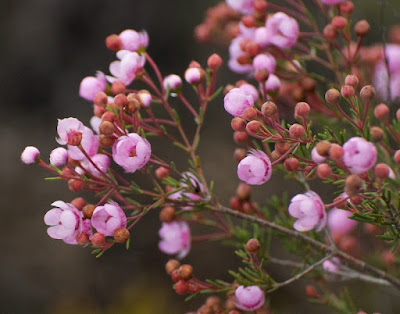




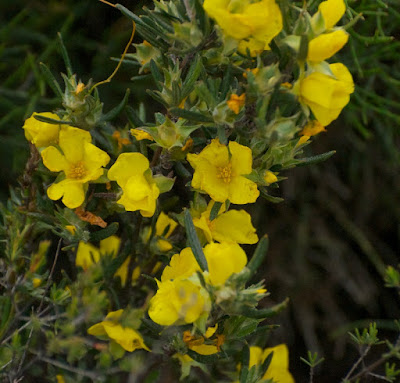





No comments:
Post a Comment